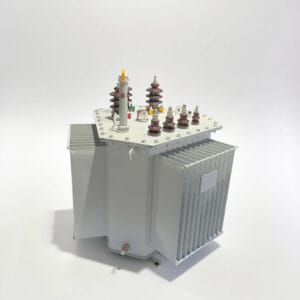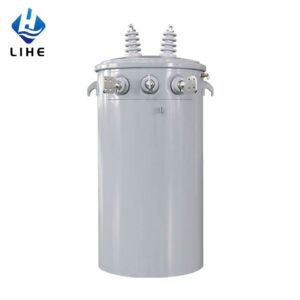Description of Single Phase Pole Mounted Transformer
- Reducing the length of low-voltage distribution lines,
- Minimizing line losses (e.g., ≤3% in accordance with IEC 60076-1),
- Improving power quality (voltage regulation of ±2% under normal load).


Parameter of Single Phase Pole Mounted Transformer
| 10kva-333kva single-phase oil-immersed transformers | ||||||
| Rated Capacity (kVA) | High Voltage (v) | Low Voltage (V) | Vector Group | standard | Short Circuit Impedance (%) | Efficiency(%) |
| 10 | 4160 7200 12000 12470 13200 13800 19920 24940 34500 | 110 220 230 400 480 | II0 , II6 | IEEE/ANSI/ DOE | 1.8-4% | 98.7 |
| 15 | 98.82 | |||||
| 25 | 98.95 | |||||
| 37.5 | 99.05 | |||||
| 50 | 99.11 | |||||
| 75 | 99.19 | |||||
| 100 | 99.25 | |||||
| 167 | 99.33 | |||||
| 250 | 99.39 | |||||
| 333 | 99.43 | |||||
Features of Single Phase Pole Mounted Transformer
- Energy-efficient wound core design: Optimized magnetic flux path reduces no-load losses (≤0.5W/kg in compliance with IEC 60076-1).
- Pole-mounted suspension installation: Compact size lowers infrastructure investment.
- Low-voltage optimization:
- Shortened low-voltage supply radius minimizes line losses (>60% reduction compared to traditional designs).
- Voltage regulation accuracy: ±1.5% under dynamic loads (per IEEE C57.12.00).
Applications of Single Phase Pole Mounted Transformer
b) Remote mountainous areas
c) Scattered villages
2. Agricultural and Residential Use:
a) Agricultural production
b) Lighting and motorized loads
3. Infrastructure Renovation:
a) Railway systems (overhead catenary power supply)
b) Urban power grid energy renovation (pole-mounted distribution lines)
FAQ about Single Phase Pole Mounted Transformer
Q1: What is a Single-Phase Pole-Mounted Transformer?
A single-phase pole-mounted transformer is a compact electrical device installed on utility poles, with a rated capacity typically ranging from 10 kVA to 333 kVA (expandable to 3 kVA–500 kVA in special scenarios). Its primary function is to step down high-voltage distribution lines (e.g., 10 kV) to low-voltage outputs (e.g., 240V/120V), serving as a critical component in the final stage of power distribution networks for residential areas and small commercial establishments with low electricity demands.
Q2: What is the Typical Capacity Range of Pole-Mounted Single-Phase Transformers?
Common capacity ratings span 10 kVA to 333 kVA, with special cases extending from 3 kVA (minimum) to 500 kVA (maximum).
- Rural/remote areas: 25 kVA or 50 kVA units are commonly used due to lower load demands.
- Urban suburbs/commercial zones: Higher-capacity units (e.g., 100 kVA+) are preferred to meet increased electricity requirements.
Q3: Key Considerations for Installing Single-Phase Pole-Mounted Transformers?
- Pole Selection: Use poles with adequate strength and stability. Mounting height must ensure a safety clearance of at least 3 metersfrom the ground to prevent human or object contact.
- Secure Fixing: Employ specialized clamps to ensure firm fixationand prevent component loosening caused by operational vibrations.
- Grounding Requirements: The grounding system must be reliable, with a grounding resistance ≤ 4 Ω, to safeguard against lightning strikes and ensure personal safety.
- Environmental Conditions: Install away from obstacles to ensure good ventilation(for heat dissipation) andreserve sufficient space for maintenance.
Q4: Differences Between Single-Phase and Three-Phase Pole-Mounted Transformers?
Comparison Criteria | Single-Phase Transformer | Three-Phase Transformer |
Output Voltage | Single-phase low voltage (e.g., 120V/240V) | Three-phase low voltage (e.g., 400V/230V) |
Application Scenarios | Low-load areas (residences, small shops) | High-load/industrial areas (factories, commercial complexes) |
Structure & Cost | Simple structure, lower cost | Complex structure, higher cost |
Q5: How to Detect Faults in Single-Phase Pole-Mounted Transformers?
- Abnormal Noises/Vibrations: Unusual humming, buzzing, or excessive vibration during operation.
- Temperature & Oil Condition(for oil-immersed transformers): Overheating (exceeding rated temperature), oil leakage, or discolored oil.
- Voltage Instability: Fluctuations in low-voltage output beyond acceptable limits.
- Physical Damage: Burn marks, cracks, or electrical discharges (e.g., sparks during rain) on the enclosure or bushings.
Q6: Maintenance Schedule for Single-Phase Pole-Mounted Transformers?
- Routine Inspections: Every 6–12 months, including exterior cleaning, connection tightness checks, oil level verification (for oil-immersed units), and bushing insulation assessments.
- Critical Maintenance Tasks:
- Oil-Immersed Transformers: Annual to bi-annual dielectric oil tests (e.g., breakdown voltage, dielectric loss factor).
- Grounding System: Yearly inspection to ensure resistance ≤ 4 Ω.
- Heat Dissipation: Regularly clean radiator fins to prevent dust accumulation.
Q7: Causes of Transformer Overheating?
- Overloading: Sustained operation beyond rated capacity, leading to increased winding losses.
- Poor Heat Dissipation: Blocked radiator fins, excessive dust/oil accumulation, or inadequate ventilation.
- Internal Faults: Winding short circuits, core insulation degradation (e.g., aging silicon steel sheets).
- Oil-Immersed Specific Issues: Low oil level or deteriorated oil quality (reduced insulation and cooling performance).
Q8: How to Protect Transformers Against Lightning or Short Circuits?
- Lightning Protection: Install zinc oxide surge arresters on the high-voltage side to limit overvoltage caused by lightning strikes.
- Short Circuit Protection: Equip high-voltage fuses (e.g., CSP-type) or circuit breakers to quickly cutfault currents and prevent winding damage.
- Enhanced Grounding: Ensure the grounding system complies with standards to minimize ground potential rise during faults.
Q9: What is the Lifespan of Pole-Mounted Transformers?
Under normal operating conditions, the typical lifespan is 20–30 years. Key factors affecting longevity include:
- Environmental Conditions: High humidity, coastal salt spray, or dusty environments accelerate insulation aging.
- Maintenance Quality: Frequent overloading or neglecting maintenance (e.g., delayed oil replacement) shortens service life.
- Manufacturing Standards: Premium materials and craftsmanship extend operational durability.

















Reviews
There are no reviews yet.